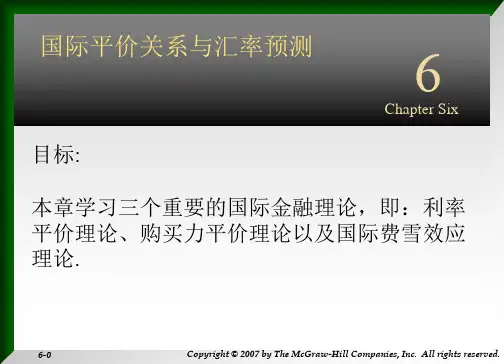国际会计学第六版chapter_6
国际会计学课件cha6 Foreign Currency Accounting

• To record foreign currency tranctions.
• The expanded scale of international investment increases the need to transfer accounting information from one country to users in others.
• *6.Foreign currency . • A currency other than the currency of the country being referred to; A currency other than the reporting currency of the enterprise being referred to. • 外币:特定国家的非本国货币;特定企业的非报告货 币. • *7.Foreign currency financial statement. Financial statement that employ foreign currency as the unit of measure. • 外币财务报表:以外币作为计量单位的财务报表.
• 2.Indirect exchange rate (quote) • (Receivable Quote 应收法) • It is the reciprocal(倒数)of the direct quote, the price of a unit of domestic currency in terms of the foreign currency. It would take approximately 0.1639 U.S dollar to acquire 1 Chinese yuan .
《国际会计学第六》PPT课件_OK

2021/9/2
11
• Revenues would be $1,500 received uniforml y over the period, expenses would be $1,000, and net income would be $500.
• Net income of $500 represents the amount t hat could be withdrawn from the firm and le ave the owners with their original investment intact.
2021/9/2
6
Why are Financial Statement Potentially Misle ading
During Periods of Changing Prices?
• During periods of inflation, revenues are based on the general purchasing power of the current period.
2021/9/2
7
• Deducting expenses based on historical purchasing power from revenues that expressed i n currency of current purchasing power yields a nonsensical index of performance.
国际会计学第六版

Conservative earnings for creditor protection. Less extensive disclosures.
Development (contin)
Legal system
Code law
Laws are all-embracing. Accounting tends to be prescriptive and
Example: the Netherlands
Independent discipline approach
Accounting derived from business practices, judgment, and trial-and-error.
Examples: U.K. and U.S.
sector professional organizations.
Development (contin)
Taxation
Must companies record revenues and expenses in their accounts to claim them for tax purposes?
Development (contin)
Level of economic development
Affects the types of transactions and which ones are most prevalent in the economy which, in turn,
Accounting values (Gray)
Professionalism vs. statutory control Uniformity vs. flexibility Conservatism vs. optimism Secrecy vs. transparency
国际财务管理第六版中文版第六章

Home currency,foreign currency
6-19
Copyright © 2007 by The McGraw-Hill Companies, Inc. All rights reserved.
利率平价与汇率决定
根据利率平价关系:
S 1if F 1 ih
如果远期汇率是对未来即期汇率做出的预期。即
远期升水和利率差异之间的关系
在利率平价的条件下,可以根据利率差异计算出远期汇率升水 或贴水。
P F S = ih if S 1if
ih i f
其中,
P——远期升水(或贴水);
F——远期汇率;
S——即期汇率;
ih——本国利率; if——外国利率。
6-16
Copyright © 2007 by The McGraw-Hill Companies, Inc. All rights reserved.
利率 和汇 率
④在远期市场上卖出英镑
6-11
Copyright © 2007 by The McGraw-Hill Companies, Inc. All rights reserved.
一、利率平价
利率平价(IRP)的定义
一旦市场力量使利率和汇率进行了调整而使得抵补 套利不再可行,这时候的这种均衡状态叫利率平价 (interest rate parity)
远期升水和利率差异之间的关系
假定墨西哥比索6个月的利率为6%,而美元6 个月的利率为5%。从美国投资者的角度看, 美元是本币。根据利率平价,比索对美元的远 期汇率升水应为:
P 5% 6% 0.94% 1 6% -1%
6-17
Copyright © 2007 by The McGraw-Hill Companies, Inc. All rights reserved.
国际会计学第六版chapter课件

3
Development of Disclosure
Voluntary disclosure
Voluntary disclosures are increasing as investors demand more detailed and timely information.
But managers’ incentives for disclosure aren’t always aligned with those of investors.
International Accounti. Meek
Chapter 5: Reporting and Disclosure
1
Learning Objectives
Distinguish voluntary and mandatory disclosure and the applicable regulatory measures.
Disclosure regulations and third party certification can improve the functioning of capital markets.
国际会计学第六版chapter_6 共42页

Choi/Meek, 6/e
5
Types of Transaction Rates
Spot transactions: the physical exchange of one currency for another in which delivery takes place immediately.
Swap transaction: involves the simultaneous spot purchase and forward sale, or spot sale and forward purchase of a currency.
Choi/Meek, 6/e
7
Accounting for Spot Transactions
How does the temporal method of currency translation differ from the current rate method?
What is the relationship between currency translation and inflation?
Preserves the original cost equivalent of a foreign currency item in the reporting currency.
Use of historical rates do not give rise to
translation gains or losses, which are
国际会计学第六版cha(1)
Choi/Meek, 6/e
2
Have a basic working knowledge of accounting classifications and how they compare with one another.
Explain the difference between the “fair presentation” and “legal compliance” orientations of accounting and identify nations in which each is prevalent.
Choi/Meek, 6/e
5
Development
Sources of finance – who, how many, how close? Equity markets
Profits measure how well managers have run the company.
Accounting is used to assess cash flows, risks, and to value the firm.
Choi/Meek, 6/e
9
Political and economic ties
Accounting ideas and technologies are transferred through conquest, commerce, and other forces.
Inflation
Extensive disclosures.
Banks
Conservative earnings for creditor protection. Less extensive disclosures.
国际会计学第六版chapter1-
9
Contributing Factors (contin)
Growth and spread of multinational operations
Choi/Meek, 6/e
10
Choi/Meek, 6/e
11
Contributing Factors (contin)
Reporting issues when business transcends national boundaries
Choi/Meek, 6/e
5
What Does International Accounting Diversity Entail?
Measurement principles Financial disclosure (corporate transparency) Auditing practices
Dutch enhance income measurement.
Choi/Meek, 6/e
7
French use accounting for governmental planning and control.
Double entry assists the British in managing and controlling commercial interests in the colonies.
Choi/Meek, 6/e
12
•Financial innovation
Identifying potential market risks Quantifying trade-offs associated with
alternative risk reduction strategies Measuring risk exposures Accounting for specific hedge products Evaluating the effectiveness of hedging
国际会计学第六版chapter1-
Choi/Meek, 6/e
13
Contributing Factors (contin)
Global competition
Competitive benchmarking necessitates international comparisons.
Choi/Meek, 6/e
Choi/Meek, 6/e
5
What Does International Accounting Diversity Entail?
Measurement principles Financial disclosure (corporate transparency) Auditing practices
Dutch enhance income measurement.
Choi/Meek, 6/e
7
French use accounting for governmental planning and control.
Double entry assists the British in managing and controlling commercial interests in the colonies.
International Accounting, 6/e Frederick D.S. Choi Gary K. Meek
Chapter 1: Introduction
Choi/Meek, 6/e
1
Learning Objectives
How is international accounting distinct from domestic accounting?
国际会计第六版教学设计
国际会计第六版教学设计一. 教学目标本课程的目标是:1.让学生了解国际财务报告的背景与作用;2.帮助学生掌握财务会计部分的相关知识;3.告诉学生如何比较与分析财务报告;4.让学生掌握财务报告的编制与解读方法。
二. 教学内容本课程的教学内容如下:1. 国际财务报告背景与作用•国际财务报告的定义和要求•国际财务报告标准体系2. 财务会计部分•资产负债表•利润表•现金流量表3. 比较与分析财务报告•财务比率分析•财务趋势分析•财务结构分析4. 财务报告的编制与解读方法•财务报告编制准则•财务报告解读技巧三. 教学方法1.讲课:通过PPT等教案,向学生阐述相关概念和知识点。
2.分组讨论:将学生分成小组,让每组讨论财务报告相关的案例和问题,提高学生的思考和沟通能力。
3.实践操作:让学生通过财务报告解读实践操作,加深其对财务报告理解。
四. 文献资料•Deegan, C. M. (2014). Financial Accounting Theory.4th ed. United States: Mcgraw-hill.•Kieso, D. E., Weygandt, J. J., & Warfield, T. D.(2016). Intermediate Accounting.16th ed. United States: John Wiley & Sons.•IFRS2018).IFRS Standards - Consolidated without early application. International Accounting Standards Board (IASB).五. 评价方法1.学生平时表现(40%):包括参与度、思考问题能力、作业完成情况等各方面表现。
2.期末论文(60%):学生需撰写一篇不少于3000字的论文,探讨财务报告某一方面的问题,如财务比率分析等。
六. 教学日程时间教学内容第1周国际财务报告背景与作用第2-4周财务会计部分第5-6周比较与分析财务报告第7周财务报告的编制与解读方法第8-9周学生小组讨论及实践操作第10周学生期末论文答辩七. 总结思考本课程是国际会计领域的入门课程,涉及到了财务报告的方方面面,因此,在教学设计中增加了分组讨论及实践操作环节,使得学生不仅能够掌握相关理论知识,还能够在实践中不断提高自己的分析与解读财务报告的能力。
- 1、下载文档前请自行甄别文档内容的完整性,平台不提供额外的编辑、内容补充、找答案等附加服务。
- 2、"仅部分预览"的文档,不可在线预览部分如存在完整性等问题,可反馈申请退款(可完整预览的文档不适用该条件!)。
- 3、如文档侵犯您的权益,请联系客服反馈,我们会尽快为您处理(人工客服工作时间:9:00-18:30)。
Chapter 6:
Foreign Currency TranslationBiblioteka Choi/Meek, 6/e
1
Learning Objectives
Why do firms translate from one currency to another?
Facilitates reporting domestic accounts to foreign audiences-of-interest.
Choi/Meek, 6/e
5
Types of Transaction Rates
Spot transactions: the physical exchange of one currency for another in which delivery takes place immediately.
Choi/Meek, 6/e
3
Why do Firms Translate?
Facilitates the preparation of consolidated financial statements that allow readers to see the performance of a multinational company’s total operations both domestic and foreign.
Gain or loss on an unsettled transaction: arises whenever consolidated financial statements are prepared before settlement and the current rate has changed since the transaction date.
Preserves the original cost equivalent of a foreign currency item in the reporting currency.
Use of historical rates do not give rise to
translation gains or losses, which are
Facilitates the measurement of a firm’s exposure to foreign exchange risk.
Choi/Meek, 6/e
4
Facilitates the recording of foreign currency transactions; i.e., foreign currency sales, purchases, borrowing or lending in the consolidated entity’s reporting currency.
Direct quote: the exchange rate specifies the number of domestic currency units needed to acquire a unit of foreign currency.
Indirect quote: the exchange rate specifies
At the transaction date, each asset, liability, revenue, and expense denominated in a foreign currency is measured and recorded in the functional currency of the reporting entity at the spot exchange rate in effect on that date.
What is the difference between a spot, forward, and swap transaction?
What exchange rates are used in the currency translation process and what are their financial statement effects?
At each balance sheet date, recorded balances denominated in a currency other than the functional currency of the reporting entity is adjusted to reflect the current exchange rate.
the price of a unit of the domestic currency in
terms of the foreign currency.
Choi/Meek, 6/e
6
Forward transaction: agreements to exchange a specified amount of one currency for another at a future date.
Choi/Meek, 6/e
9
Accounting for Spot Transactions (contin)
A foreign exchange gain or loss is recorded whenever the exchange rate changes between the original transaction date and the settlement date, or between the original transaction date and the financial statement date should financial statements be prepared prior to settlement.
Spot transaction: occurs when an enterprise purchases or sells goods for which payment is made in a foreign currency, or when it borrows or lends foreign currency.
Choi/Meek, 6/e
2
How does a translation gain or loss differ from a transactions gain or loss?
Is there more than one way of translating financial statements from one currency to another? If so, what are they?
Choi/Meek, 6/e
8
Functional currency is the primary currency in which the reporting entity transacts business and generates and spends cash; e.g., dollars in the case of a U.S. reporting entity.
Choi/Meek, 6/e
10
Example: On September 1, a calendar year U.S. manufacturer sells, on 90-day credit, goods to a Swedish importer for SEK 1,000,000. The dollar/krona exchange rate is $0.14 = SEK1 on September 1, $0.13 = SEK 1 on September 30, and $0.11 = SEK 1 on December 1.
Translation gains or losses: result from a restatement process.
Transactions gains or losses: result from the physical exchange of one currency for another.
Average rate: a simple or weighted average of either historical or current exchange rates.
Choi/Meek, 6/e
14
Translation vs. Transaction Gains or Losses
Choi/Meek, 6/e
15
Gain or loss on a settled transaction: arises whenever the exchange rate used to book the original transaction differs from the exchange rate used at settlement.
Choi/Meek, 6/e
11
Choi/Meek, 6/e
12
Types of Translation Rates and their Statement Effects
Historical rate: the exchange rate prevailing when a foreign currency asset was first acquired or a foreign currency liability first incurred.
Swap transaction: involves the simultaneous spot purchase and forward sale, or spot sale and forward purchase of a currency.
